Day 1 of a two day Private Tour for a guest from Hong Kong. We would spend the two days along the North Norfolk coast looking for a good selection of both our commoner breeding birds and any more interesting species we might come across. We would be trying to get photographs of as many of the birds as possible too. Today was sunny and hot, although with a bit of hazy cloud in the afternoon and a pleasant light breeze on the coast which meant it didn’t get too uncomfortable.
Our first stop was at Wells. As we walked down along the track, there were lots of Reed Buntings in the bushes. A couple of Common Whitethroat flitted off ahead of us – we could see their rusty wings when they perched in the open briefly. A much greyer warbler was a Lesser Whitethroat which landed together with one of them in a bush at one point.

Looking up, we saw a Spoonbill flying in from the direction of the harbour, its neck held outstretched in front. It landed at the back of the pool on the other side of the track, and training the scope on it we could see there were now five Spoonbills together there, along with several more Little Egrets too.
The pools nearest the track are drying up fast now, so most of the birds were over towards the back. There were lots of Greylag Geese and in with them a mix of ducks, Teal and Shoveler. We could see several Black-tailed Godwits in the deeper water and a single Common Snipe probing vigorously in the mud with its long bill, but it was rather distant and we were looking into the sun.
On the other side of the track, we found a single Green Sandpiper in the shallow pools and an adult Mediterranean Gull flew over, flashing its white wing tips, disappearing out towards the saltmarsh. There were lots of birds in the distance over Wells town, mostly Starlings but we picked up a few lingering Common Swifts still too, zooming back and forth. It won’t be long now before they have all left us.
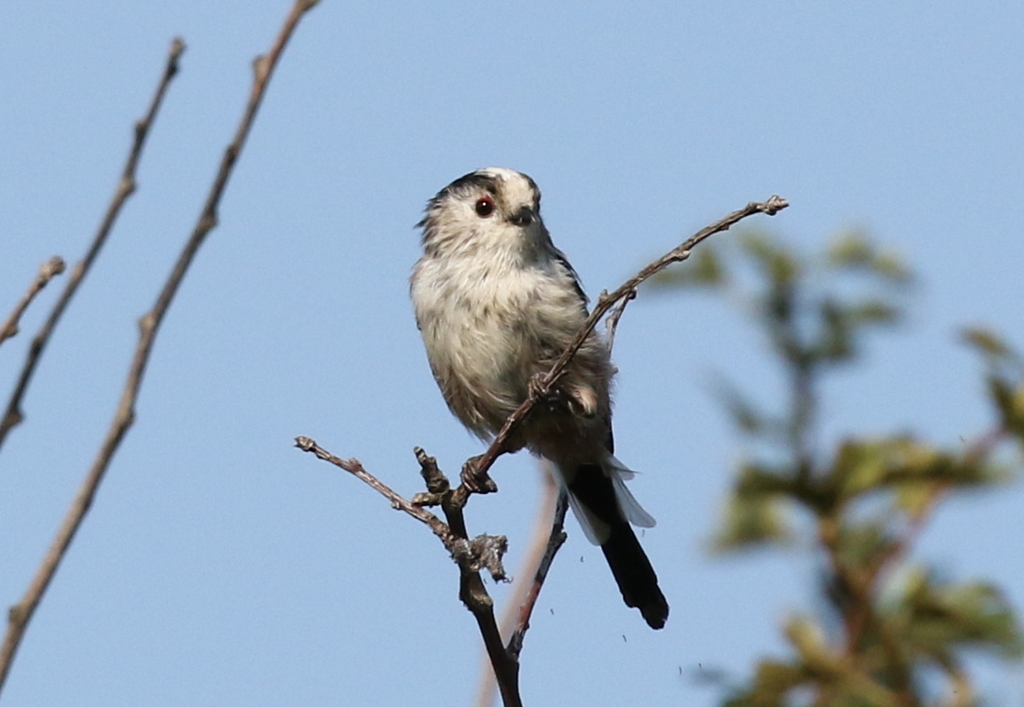
Continuing on past the pools, we decided to have a look in the bushes to see if there were any more warblers here, given the early activity along the track. We could hear Blackcap and Chiffchaff calling and although they proved hard to see initially, we eventually got views of both species here. There were Chaffinches in the hedge too, and a flock of tits zipped through pausing to feed in the bushes, the Blue Tits attacking some elder berries and a Long-tailed Tit showing well in the top of a hawthorn.
When the tit flock moved on, we walked round to see if we could find it further along. There were more birds here but no sign of the Long-tailed Tits so maybe a different group. We stopped by one hawthorn on the edge of a reedy ditch, where there was a succession of birds moving through. Several Blue Tits and another Lesser Whitethroat. Then a couple of Reed Warblers, which gave good views up out of the reeds here.
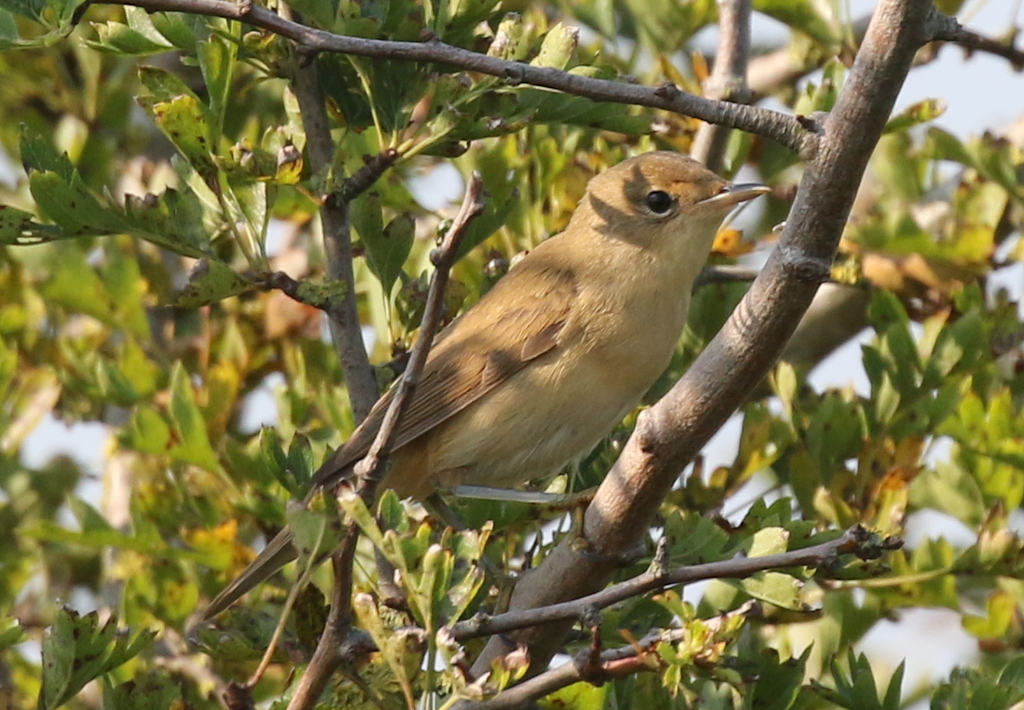
As the flock moved on again, we continued round. A small bird appeared on the top of one of the bushes in the middle. Its bold pale supercilium caught the morning sun, a Whinchat, a passage migrant and a real bonus to find one here. It perched up nicely a couple of times for us, before disappeared behind the bushes. When we turned round, a different bird was perched on the top of a small hawthorn behind us, this time a Wheatear. Another passage migrant passing through, it flicked away over the reeds flashing the white base to its tail.
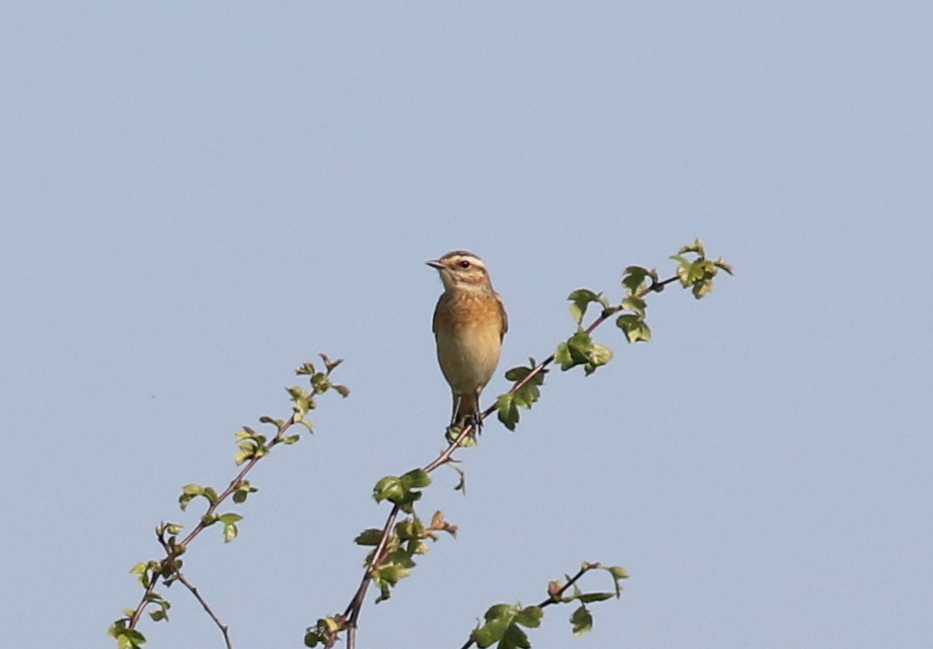
As we walked back along the track, there were still lots of Reed Buntings which flew up from the vegetation and landed in the bushes. A Yellowhammer flew in calling and joined them briefly, before dropping down into the long grass out in the middle.
When we got back to the minibus, a couple of other birders had their scopes on the pools and had found a wader asleep on one of the islands at the back. It was hard to tell what it was, hunkered down and at distance in the heat haze, but as we started to pull away they called over to say that it had woken up and started to walk around, a Greenshank.
Our next destination was Cley, but we ran into gridlock in Stiffkey village, with a long tailback of vehicles, probably due to one of the much bigger buses they are using for the revised Coasthopper service these days – it seems to be an increasing problem. Thankfully, we could take a diversion inland and were not held up this time. Two Stock Doves on the roof of a barn by the road were a nice bonus, the iridescent green on the side of one of the bird’s neck glowing in the sun.
When we got to Cley, we decided to head out to Bishop Hide first. As we walked into the hide, we were pointed to six Common Snipe on the mud right in front. We had a good look at them but they were already looking round nervously and were quickly spooked and flew off further back.
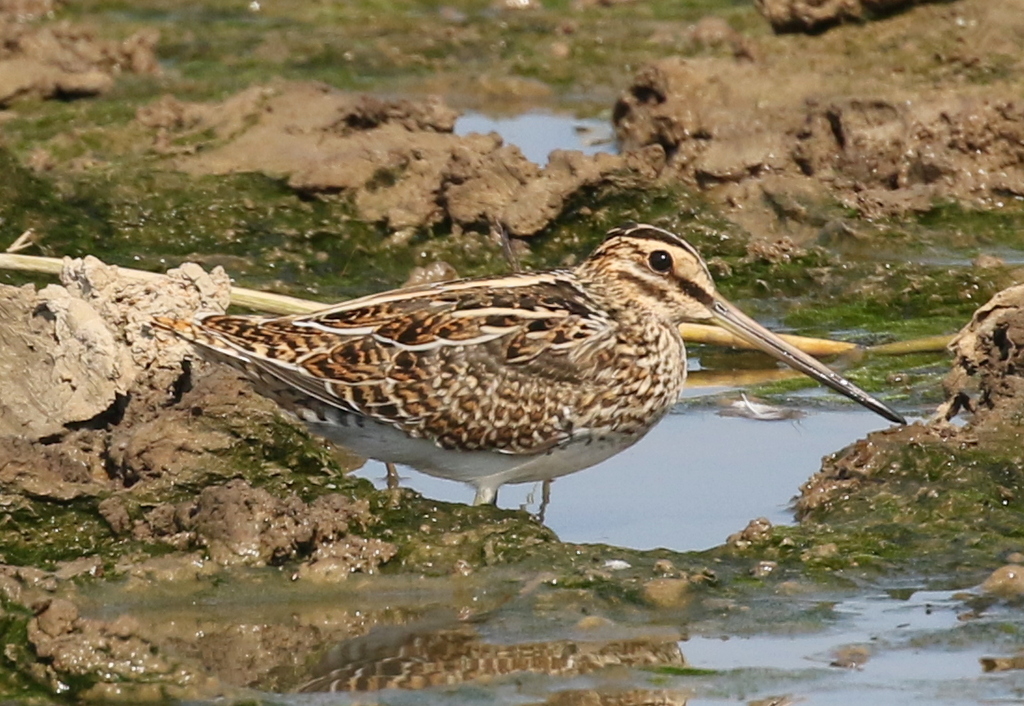
There were lots of other waders on the scrape here further back. Two juvenile Curlew Sandpipers were feeding in with a few Dunlin. A delicate, spangled-backed Wood Sandpiper was picking around the lumps of mud in front of one of the islands with several Ruff. Black-tailed Godwits were scattered liberally around and there were a handful of Knot too.
When someone in the hide announced there was a Bearded Tit, we initially thought they meant it was in the reeds right at the back, where they have often been recently. But they had heard one calling from the reeds just out to one side of the hide, so we walked over to take a look. A cracking male Bearded Tit climbed up one of the reed stems. It quickly shuffled down again, but then came up a second time and perched in full view. We had a great look at its powder blue head and black moustaches, before it flew across in front of the hide and disappeared into the reeds the other side.

As we made our way along the skirts path to the other hides, we could see a Marsh Harrier distantly hunting out over the reeds towards the West Bank. It gradually worked its way towards us and we eventually met it halfway, a dark male. When it saw us, it turned and heading off over the scrapes, flushing everything in the process.

There were a few more waders on Simmond’s Scrape when we got into Daukes Hide. Four Avocets were asleep on the front of the nearest island – they did wake up later and a couple spent some time feeding on the mud in front of the hide. There were several Ringed Plovers on the mud further back and a single Golden Plover which was easily overlooked in the lumps where the cattle had churned up the scrape. The tiny Little Stint was even harder to find in the same place!
Looking out of the side of the hide, we could see 3-4 Green Sandpipers on Whitwell Scrape. One gradually worked its way down to the front, where it was hidden behind some small wisps of reed from where we were. We decided to head round to Avocet Hide to try to catch it right in front – with our cameras – but just as we got into the hide, one of the other Green Sandpipers flew over and chased it off. The two of them flew over the bank to Simmond’s Scrape.
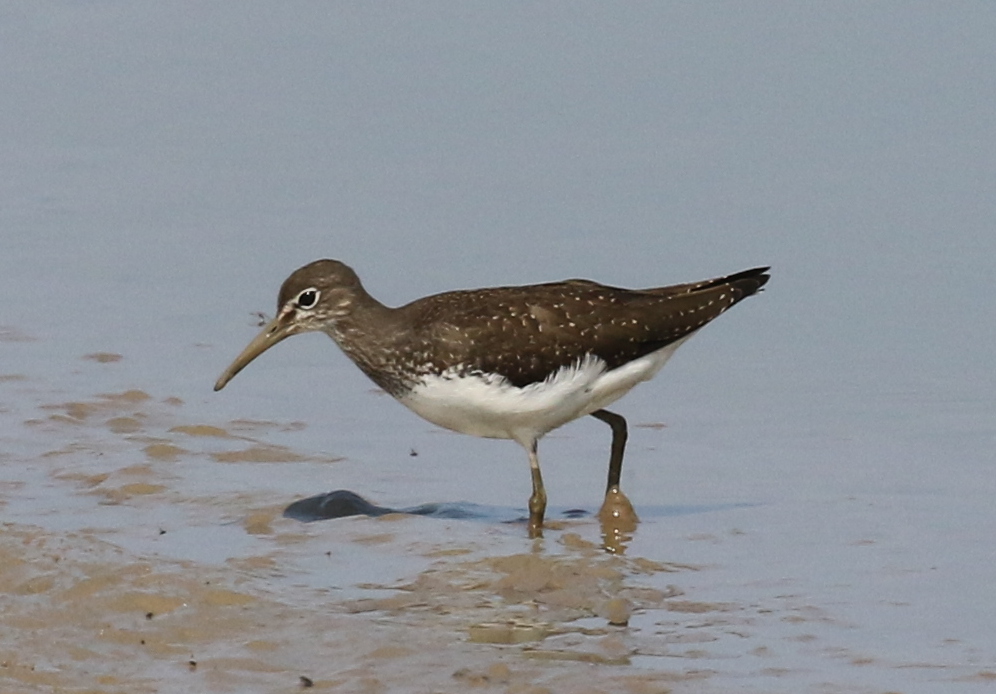
There were also two juvenile Black-tailed Godwits on the scrape here too and one of them did walk over and round the edge right in front of the hide. Some consolation for the photographers! Their rusty necks and extensively marked feathers on the upperparts showed they were both juveniles of the Icelandic race.

Before we raced round to try to catch the Green Sandpiper, there had been a Wood Sandpiper feeding on the mud in front of Teal Hide. By the time we made it round there, the Wood Sandpiper had moved further back but we could see several Dunlin feeding on the mud just to the right of us with one of the two Curlew Sandpipers in attendance. They were busy feeding and working their way towards us and eventually passed in front of the hide giving us a great view.
It was time for lunch now, so we made our way back to the Visitor Centre and made good use of the picnic tables. It was a lovely day to be sitting outside looking out over the marshes. After lunch, we popped into the Centre briefly and when we came out again we could hear Whimbrel calling. They responded to a whistled response and two of them flew in towards us, at least until they realised that the impression was not really as good as it sounded at a distance. They circled back and dropped down towards the scrapes.

We drove round to Walsey Hills next. As we got out of the minibus, we could see a Little Grebe on the pool, though it was doing its best to hide in the cut reed stems at the back. We had a quick walk in along the footpath through the bushes, to see if we could pick up any more passerines for the list, but it was rather quiet – perhaps not surprising in the middle of a hot afternoon. A few Blue Tits were in the bushes around the feeders and we could hear a couple of Chiffchaff calling.
There was no sign of the Common Pochard which has been on Snipe’s Marsh, but we found it instead on Don’s Pool along with another Little Grebe, as we set off to walk up the East Bank. There were more ducks on the Serpentine – mainly Gadwall and Shoveler, and lots of Shelduck. None of them are looking their best at the moment, with the drakes currently in their drab eclipse plumage. A Green Sandpiper flew up from the mud, there were a couple of Redshanks along the edge of the water and several Lapwing in the grass.
Continuing on to Arnold’s Marsh, we could see a single Great Black-backed Gull standing in with all the loafing Cormorants on the island at the back, leaving not much room for anything else. One Sandwich Tern was standing on the mud further across. There were quite a few Curlew over in the vegetation in the back corner and several Redshanks on the mud, but nothing else on here today.
As we walked on towards the beach, we noticed some movement in the vegetation on the side of the path. A Willow Warbler flicked out. It started to fly off but then circled round and dropped back in to the spot it had just left in a seedy dock. This is not a place you would normally expect to find a Willow Warbler, so this was probably a migrant which had just arrived in off the sea, over from Scandinavia. Exhausted, it was trying to feed and was obviously reluctant to leave the plants where it had found something to eat.
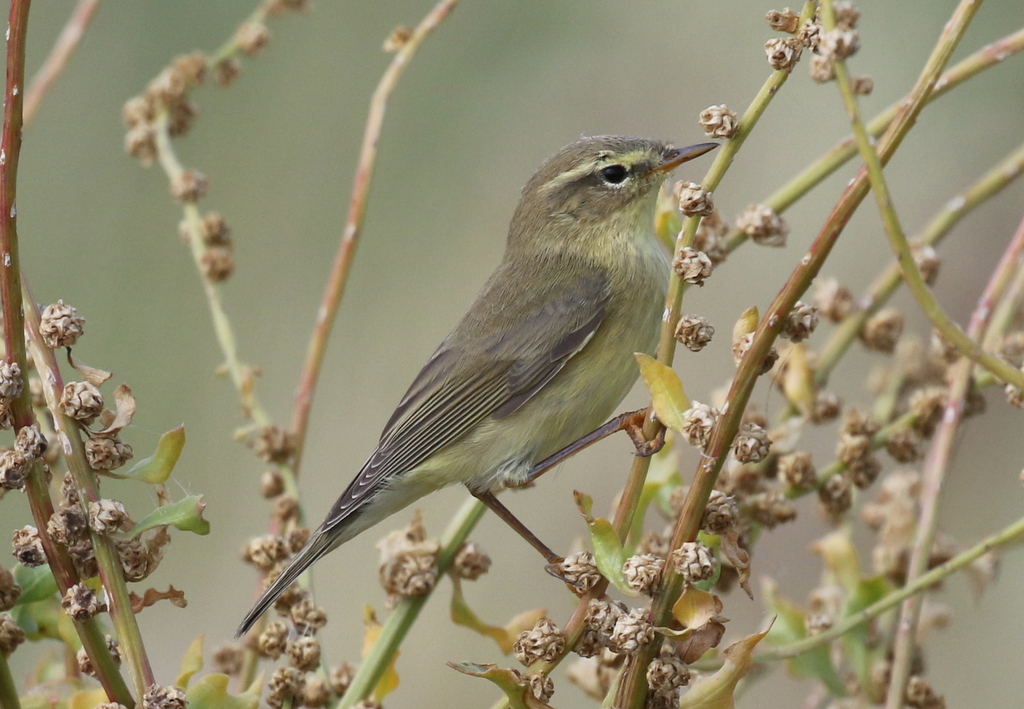
A little further on, a couple of Meadow Pipits were also looking for insects in the vegetation along the side of the path and flew off as we approached. We carried on out to the beach and had a quick look at the sea, which was mostly quiet apart from a single immature Gannet which flew past.
Having made our way back to the minibus, we drove back west to our last stop of the day at Stiffkey Fen. The permissive path is very overgrown at the moment, so we walked rather carefully down along the road to get to the footpath. The bushes down by the river were quiet, but there were lots of House Martins over the field.
When we got to the spot where the brambles are low enough to see over, we had a look across at the Fen. We could see lots of white shapes in amongst the hordes of geese – mostly Spoonbills, along with a good number of Little Egrets. We had a better view from up on the seawall, from where we could get a more accurate count – we could see at least 47 Spoonbills today, mostly doing what Spoonbills like to do best and sleeping! One or two were preening or bathing so we could see their distinctive spoon-shaped bills.
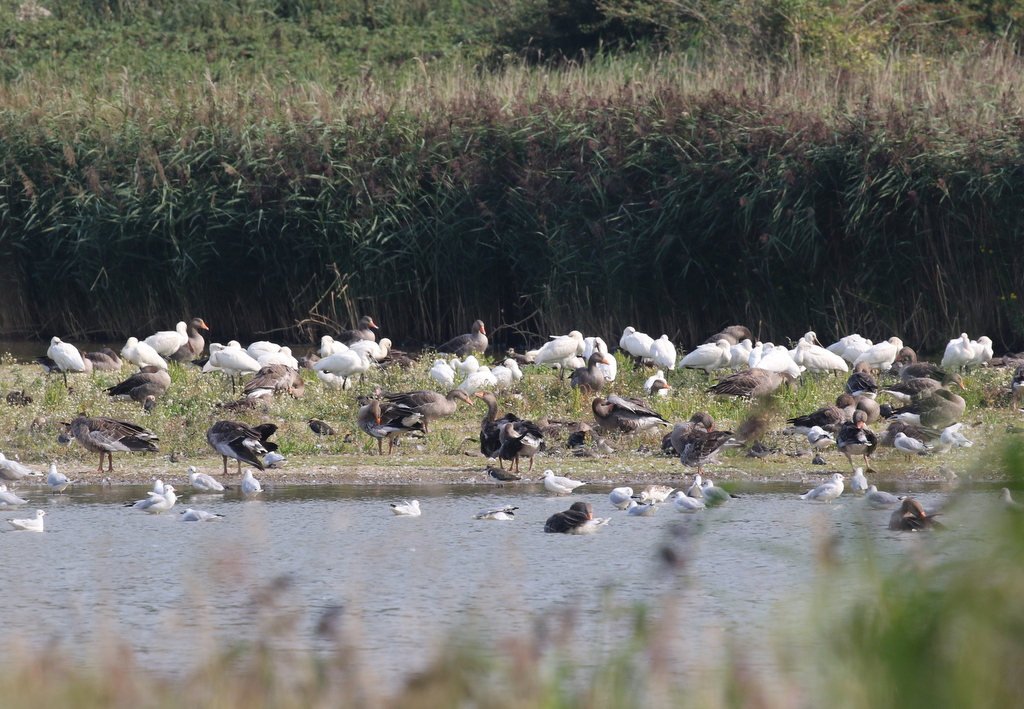
It was high tide out in the harbour, which was why the Spoonbills had gathered here to roost. An impressive sight at this time of the year, they are birds which have dispersed from the breeding colony at Holkham, a mixture of adults and juveniles from this year’s breeding season.
There was a good selection of waders on the Fen too, also roosting over high tide. We counted at least 14 Greenshanks, half in a group on their own but half roosting with some of the Common Redshanks. There were lots of Black-tailed Godwits and a few Ruff, with several more of the former still flying in from the harbour while we were there. Scanning round the edge of the reeds we found 2-3 Green Sandpipers too.
The geese were mostly Greylags but there were several Canada Geese with them and at least one Greylag x Canada Goose hybrid! Looking carefully through the mass of ducks produced one rusty eclipse drake Wigeon, an early returning bird back for the winter from spending the breeding season in Russia.
We carried on round to the harbour to see if we could pick up any different waders round the shore, but despite it being midweek there were still lots of holiday makers here making the most of the lovely weather, swimming, sailing and walking out across the mud. There was a big flock of Oystercatchers right out in the middle of the harbour on a sandbank, and through the scope we could see about ten Bar-tailed Godwits with them. But there was nowhere else which was undisturbed enough for birds to roost.
It was time to head back. A Chiffchaff was calling in the hedge and in the sallows along the river we came across another tit flock, which gave some more opportunities to try to get Long-tailed Tit photos. It had been a great day – let’s hope for the same again tomorrow…
















